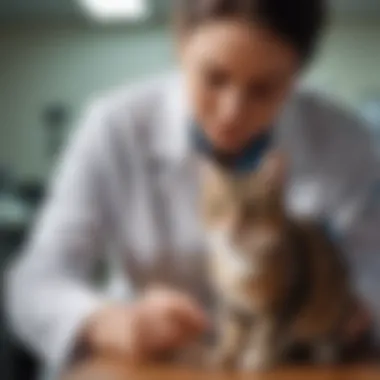Identifying a Urinary Tract Infection in Cats: A Guide


Intro
Recognizing the health of your cat is fundamental for their well-being. One common yet often overlooked health issue is a urinary tract infection (UTI). Cats, being naturally reserved creatures, can mask their discomfort, making it crucial for pet owners to be vigilant about any changes in behavior or habits. This guide aims to equip you with the necessary knowledge to identify signs and symptoms of a UTI, understand the related epidemiology, and explore diagnostic and treatment options available for your feline friend.
Understanding Your Pet
Cats exhibit unique characteristics that can significantly impact their health. Understanding the traits of your cat's breed can help in identifying issues like UTIs more effectively.
Breed Traits
Certain breeds may have predispositions to urinary issues. Breeds like Persian or Siamese cats may experience urinary problems more frequently. Understanding your cat's breed traits can provide valuable insights into their health risks.
Common Temperaments
Cats have varying temperaments that can influence their behavior when unwell. Some may become more withdrawn, while others may show signs of agitation. Notice any changes in their mannerisms, as these can signal an underlying issue, such as a UTI.
Special Needs
Each cat is unique and may have special needs based on age, health history, and breed. Older cats, for instance, require more attention. It is essential to cater to these needs to maintain overall health and to monitor for any signs of urinary distress.
Pet Care Essentials
Proper care is vital for maintaining your cat’s health and preventing issues like UTIs. Here are essential aspects to consider.
Nutrition and Feeding Guidelines
A balanced diet can reduce the risk of UTIs. Ensure your cat receives high-quality food that is appropriate for their age and health status. Consult your veterinarian for tailored feeding recommendations.
Grooming Tips and Techniques
Regular grooming can help maintain your cat’s hygiene. Keeping the fur clean, especially around the genital area, may reduce the chances of developing a UTI. Use cat-specific grooming tools to avoid any discomfort.
Health and Wellness
Routine veterinary check-ups can play a crucial role in early detection of health issues. Ensure your cat is up to date on vaccinations and discuss any concerns with your veterinarian to prevent urinary tract infections and other ailments.
Training and Behavior
Understanding your cat's behavior is important in detecting health problems.
Basic Training Techniques
Training your cat to use the litter box properly can prevent initial urinary issues. Ensure the box is clean and accessible. Training can also help establish a routine, allowing you to monitor any abnormal behaviors.
Behavioral Problems and Solutions
If your cat begins exhibiting abnormal urination behaviors, it may indicate a UTI or other health issues. Identifying these changes quickly is crucial for timely intervention.
Mental Stimulation Activities
Engage your cat in stimulating activities to keep them active and healthy. Boredom may lead to stress, which can impact their physical health. Providing toys can help maintain mental well-being.
Engaging with Your Pet
Interaction with your pet is key to understanding their health better.
Interactive Games and Toys
Playtime promotes physical activity. Use feather toys or laser pointers to encourage movement. Pay attention to your cat’s enthusiasm; any sudden decrease may be a signal of discomfort.
Safe Outdoor Activities
Supervised outdoor time can enrich your cat’s life. Make sure they have a safe environment where they can explore without the risk of encountering harmful substances or sharp objects.
Family-Friendly Pet Interactions


Encourage family members to be gentle and kind while interacting with the cat. This creates a trusting environment where the cat feels safe to display any unusual behaviors.
Pet Adoption and Integration
If considering a new cat, proper adoption and integration are necessary to reduce stress for both the new pet and resident animals.
Choosing the Right Pet for Your Lifestyle
Select a cat that aligns with your lifestyle. Understand the energy levels and health needs of different breeds. This will help you manage their health effectively.
Preparing Your Home for a New Pet
Before bringing a new cat home, ensure your environment is safe and welcoming. Provide a tranquil space where the cat can acclimate to their new surroundings.
Tips for Smooth Prelude
If introducing a new cat to an existing pet, gradual introductions are essential. Monitor their interactions closely to prevent stress and ensure harmonious coexistence.
By staying informed and observant, you can significantly affect your cat's health and quality of life. Understanding the signs of urinary tract infections is a critical step in ensuring their well-being.
Prelude to Urinary Tract Infections in Cats
Urinary tract infections (UTIs) are a significant concern for cat owners. Understanding these infections helps in early detection and effective treatment. This knowledge is crucial since it can prevent serious complications that may arise from untreated UTIs. Many pet owners are unaware of the symptoms their cats may exhibit, which can lead to delays in seeking veterinary assistance.
Definition of Urinary Tract Infection
A urinary tract infection in cats occurs when harmful bacteria invade their urinary system. This can include the bladder, urethra, or kidneys. UTIs can be categorized as lower urinary tract infections or upper urinary tract infections, depending on the area affected. The most common type in cats is cystitis, which involves inflammation of the bladder. Symptoms might include increased frequency of urination, discomfort during urination, or blood in urine. If ignored, these infections can escalate, causing severe health issues.
Relevance to Pet Owners
For pet owners, being knowledgeable about UTIs is vital. When a cat shows signs of discomfort, it may indicate an underlying issue such as a UTI. Early recognition and action are essential in limiting the health risks to the cat. Moreover, understanding these infections allows pet owners to provide better care and prevention strategies. These may include proper hydration and diet to support their feline's urinary health.
It is important for cat owners to be aware of the signs of urinary tract infections to ensure timely medical intervention.
In summary, this section provides a foundational understanding of urinary tract infections in cats, emphasizing the importance of pet owners' awareness and the need for timely actions.
Epidemiology of UTIs in Cats
Understanding the epidemiology of urinary tract infections (UTIs) in cats is critical for pet owners. This section emphasizes the significance of recognizing the patterns and factors that contribute to UTIs. By comprehending how these infections manifest in feline populations, owners can better safeguard their cats' health and take preventative measures as necessary.
Prevalence of UTIs in Felines
Urinary tract infections are not as commonplace in cats as they are in dogs, but they still pose a significant health concern. Studies indicate a prevalence ranging from 1% to 10% among domestic cat populations. Factors, such as age and health status, influence these numbers, leading to variations in frequency observed. Older cats are particularly susceptible, as their immune systems may be compromised, and health issues can compound risks.
Regular monitoring and awareness of your cat’s health can lead to early detection and timely treatment, reducing complications.
Risk Factors for UTI Development
The development of UTIs in cats is multifactorial. Several risk factors contribute significantly to the occurrence of these infections.
Age and Gender
Age plays a crucial role in the likelihood of a UTI. Senior cats are more prone to urinary issues due to declining renal function and concurrent health problems. Male cats have a higher risk compared to females, primarily due to anatomical differences. Males may suffer from urethral blockages, complicating urinary tract issues. Educating oneself about these aspects can empower cat owners to be vigilant and proactive.
Underlying Health Conditions
Underlying health conditions, such as diabetes or renal disease, can predispose cats to UTIs. These conditions alter the immune defenses, making cats more vulnerable to infections. Recognizing these contributing health issues is essential for pet owners. Regular veterinary check-ups can help monitor and manage these conditions effectively. Awareness of these risks encourages pet owners to take steps for prevention and early intervention.
Lifestyle Factors
Lifestyle factors such as diet and hydration significantly affect a cat's urinary health. Cats that consume dry food without adequate water intake may face a higher risk for UTIs. This is due to concentrated urine, which can harbor bacteria. Providing fresh water and considering special diets designed for urinary health can mitigate risks. Monitoring your cat's hydration is a simple yet effective strategy for prevention.
Regular observation and understanding of these risk factors can contribute to better health outcomes for cats. Pet owners should remain engaged in their cats' health, utilizing knowledge to identify signs early.
Recognizing Symptoms of a UTI in Cats


Recognizing the symptoms of a urinary tract infection (UTI) in cats is crucial for timely intervention. When owners are aware of these symptoms, it leads to faster veterinary consultations. Early detection often results in more effective treatment, reducing the risk of serious complications. Therefore, understanding how to recognize these signs is essential for maintaining a cat's health and well-being.
Common Signs to Observe
Pet owners should be attentive to the common signs that may indicate a UTI in cats. Some indicators include:
- Frequent urination, even in small amounts
- Straining to urinate or vocalizing during attempts
- Sudden changes in behavior or appetite
- Withdrawal from social interactions
- Signs of discomfort when being touched, especially around the abdomen
These symptoms can vary in presentation, but recognizing them serves as an important first step in addressing the underlying issue.
Behavioral Changes Indicative of Pain
Behavioral alterations often serve as early warning signals that something is wrong. Cats are generally good at hiding discomfort, so look for subtle changes. A cat that suddenly becomes irritable or reclusive might be suffering from pain due to a UTI. Other behaviors may include excessive grooming of the genital area or reluctance to use the litter box. Monitoring such shifts can provide key insights into your cat’s health.
Physical Symptoms
Understanding physical symptoms can enhance a pet owner’s ability to identify potential UTI cases.
Frequent Urination
Frequent urination is a hallmark symptom of a urinary tract infection. A cat may visit the litter box more often than usual, producing little or no urine. This behavior signals that something is obstructing the normal flow or causing irritation. Recognizing frequent urination allows for quicker veterinary intervention if needed, making it a central focus of this guide.
Straining to Urinate
Straining to urinate is another critical sign. If you observe your cat attempting to urinate but struggling, this can be distressing. It often indicates that the cat is experiencing pain or discomfort. This symptom is significant, as it can lead to more severe issues such as blockages or bladder ruptures if not addressed swiftly.
Blood in Urine
The presence of blood in urine, known as hematuria, is an alarming symptom often associated with a urinary tract infection. Not only does it indicate irritation or injury to the urinary tract, but it can also signal a more serious underlying issue. The color variation can range from pale pink to bright red, which should prompt an immediate veterinary consultation. This symptom is particularly crucial, as it can be life-threatening if neglected. Ensuring to monitor for blood is essential for responsible pet ownership.
Early recognition of UTI symptoms can significantly reduce risks and improve the effectiveness of treatment options.
Diagnostic Procedures
Understanding the diagnostic procedures related to urinary tract infections (UTIs) in cats is vital for effective treatment and management. Accurate diagnostics ensure that pet owners can respond promptly to their cat's health issues. It allows veterinarians to determine the underlying cause of a UTI, tailor appropriate treatments, and choose the right preventive measures. This section emphasizes the importance of early detection and the role various diagnostic methods play in safeguarding the health of feline companions.
Initial Veterinary Consultation
The initial veterinary consultation serves as the first step in addressing a suspected urinary tract infection in cats. During this visit, the veterinarian will collect relevant information regarding the cat's symptoms, behavior, and medical history. This qualitative data collection is crucial in forming a preliminary assessment.
Veterinarians often perform a physical examination, which may include checking for pain in the abdomen or bladder area. This will allow veterinarians to establish a possible diagnosis based on the symptoms presented. Moreover, pet owners should be ready to provide as much detail as possible about their cat’s recent behavior, as this can guide the diagnostic process.
Laboratory Tests and Imaging
Laboratory tests and imaging techniques are essential for confirming a suspected UTI. These methods enhance the accuracy of the diagnosis and inform the treatment plan, ensuring that the pet receives the best care possible.
Urinalysis
Urinalysis is a fundamental diagnostic test for urinary tract infections. This analysis examines the physical, chemical, and microscopic properties of the urine. It reveals important indicators, such as urine concentration, pH balance, and the presence of red or white blood cells. The detecting of bacteria or crystals in the urine can provide significant insights into the infection status.
One of the primary advantages of urinalysis is that it is non-invasive and can be performed quickly. While it can sometimes yield inconclusive results, it remains a popular choice among veterinarians for initial assessments. It’s important to note that results may require follow-up tests for a comprehensive diagnosis.
Urine Culture
A urine culture takes diagnostic procedures a step further. This test identifies specific bacteria present in the urinary tract, allowing veterinarians to determine the best antibiotic treatment. Urine culture is particularly beneficial because it tests for bacterial resistance, enabling targeted therapy.
However, it may take longer to get results from a urine culture, often requiring a few days. Despite this, the clear identification of pathogens makes it a valuable procedure, especially when choosing antibiotics.
Ultrasound and X-rays
Ultrasound and X-rays are imaging techniques that help visualize the structures of the urinary tract. These procedures are used to identify any underlying physical issues like blockages, stones, or abnormalities. Ultrasound is especially beneficial because it provides real-time visualization, allowing veterinarians to assess the condition of urinary organs more thoroughly.
The main drawback of these imaging techniques is that they may require sedation or anesthesia, making them more invasive. However, their ability to reveal structural problems is invaluable in developing a complete treatment strategy.
Treatment Options for UTIs


Understanding treatment options for urinary tract infections in cats is essential for pet owners. Knowing the available therapies can help in making informed decisions when a UTI is suspected or diagnosed. Prompt and effective treatment can alleviate suffering, prevent complications, and enhance the overall health of your cat.
Antibiotics and Medications
When diagnosed with a UTI, cats typically receive antibiotics as the primary treatment. These medications work by eliminating the bacteria causing the infection. The choice of antibiotic depends on the specific bacterial strain identified and the cat's overall health.
Common antibiotics include:
- Amoxicillin
- Cephalexin
- Clavamox
The duration of treatment usually lasts from 7 to 14 days. It's important to complete the entire course, even if the symptoms seem to resolve sooner. Incomplete treatment can lead to antibiotic resistance, making future infections harder to treat. Side effects may occur, so monitoring your cat during treatment is crucial. If any unusual behavior or signs appear, contact your veterinarian immediately.
Supportive Care and Home Remedies
Supportive care plays a critical role in the recovery process from UTIs. Providing a comfortable environment can help your cat feel more relaxed and aid in healing. Here are simple supportive measures:
- Ensure hydration: Encourage your cat to drink plenty of water. Hydration can help flush out bacteria from the urinary tract. You can do this by providing fresh water daily or using a pet water fountain.
- Dietary changes: Some urinary diets can acidify the urine, making it less conducive for bacteria growth. Consult your veterinarian for diet recommendations tailored for your pet.
- Comfort measures: Keep your cat calm by creating a stress-free environment. Offer soft bedding and quiet spaces where they can rest.
Home remedies can also complement medical treatment but should be approached with caution. Consultation with a veterinarian is advised before introducing any alternative remedies. Herbal products like cranberry extracts are sometimes suggested, though their efficacy can vary. Prioritize your veterinarian’s advice over unverified remedies.
It is crucial to act decisively if a UTI is suspected. Healthier pets contribute to a thriving human-animal bond.
Maintaining regular veterinary check-ups can help catch health issues early and prevent future UTIs. Keeping a close eye on changes in your cat’s urination habits can also alert you to potential problems early on.
Preventing Urinary Tract Infections
Preventing urinary tract infections (UTIs) in cats is critical for maintaining their health. UTIs can lead to discomfort, serious health issues, and costly veterinary bills. By taking proactive measures, pet owners can significantly reduce the risk of these infections. Understanding dietary considerations, ensuring proper hydration, and scheduling regular veterinary check-ups are strategies that play a key role in prevention.
Dietary Considerations
Diet influences a cat's overall health, including their urinary tract condition. A balanced diet helps maintain a proper pH level in the urine. High-quality, moisture-rich foods such as wet cat food can reduce the concentration of minerals and prevent the formation of urinary crystals. Here are some points to consider:
- Nutritional Balance: Diet should include proteins, vitamins, and essential nutrients.
- Avoiding Fillers: Low-quality food may contain fillers that can lead to urinary changes.
- Specialized Diets: Consult with a veterinarian about specialized diets for cats prone to UTIs.
A consistent, high-quality diet can make a significant difference in a cat's urinary health.
Hydration and Water Access
Hydration is essential for flushing out toxins and preventing infections. Cats often do not drink enough water, which increases the risk of concentrated urine. To foster better hydration:
- Fresh Water Daily: Always provide fresh and clean water.
- Multiple Water Sources: Place water bowls in different areas of the house.
- Water Fountains: Many cats are attracted to flowing water, making pet water fountains a good solution.
Adequate water intake determines the dilution of urine and helps in lowering the risk of UTIs.
Regular Veterinary Check-ups
Regular veterinary check-ups are vital for the early detection and management of health issues. These routine visits can help in:
- Monitoring Health: Ensure your cat is free of underlying conditions that could contribute to UTIs.
- Vaccinations and Preventive Care: Keep vaccinations up-to-date to prevent diseases that could lead to urinary issues.
- Advice and Guidance: Veterinarians can provide tailored advice suited to your cat’s specific needs and lifestyle.
Being proactive in health care is a key element in preventing urinary tract infections in cats. Regular check-ups can save time, money, and discomfort in the long run.
The End
The significance of recognizing urinary tract infections in cats cannot be overstated. This article has explored the symptoms, diagnostic methods, treatment plans, and preventive measures associated with UTIs. For pet owners, being knowledgeable about these issues means that they can take prompt action if their cat shows signs of a UTI. Early intervention is crucial; it can lead to a better prognosis, minimizing the potential for complications that arise from untreated infections.
Importance of Timely Action
Delaying action when a cat exhibits signs of a UTI can lead to more severe health issues. Some points to consider include:
- Progression of Infection: If a UTI is left untreated, it can escalate to a more serious condition, such as kidney infections or systemic infections.
- Increased Discomfort for the Cat: Cats are often good at hiding pain, but they can experience significant discomfort from a UTI. Quick intervention can alleviate their suffering.
- Cost-Effectiveness: Treating an infection early can often be more economical than dealing with complications that arise from a neglected UTI.
By understanding the urgency of these symptoms, pet owners can prioritize their cat's health effectively.
Encouraging Responsible Pet Ownership
Responsible pet ownership includes being attentive to any changes in a cat's behavior or health. Pet owners should:
- Stay Informed: Continuously educate themselves about feline health. Trusted resources are available online, such as articles on Wikipedia or Britannica.
- Routine Care: Regular veterinary check-ups can catch issues before they become serious, including UTIs.
- Healthy Habits: Providing a balanced diet and ensuring that cats stay hydrated can significantly reduce the risk of UTIs.
Responsibility is not just about addressing issues as they arise but also about preventive measures. Emphasizing these aspects will benefit both the owner and the cat in the long run.
Remember, being proactive in your cat's healthcare can lead to a longer and healthier life for your feline friend.



